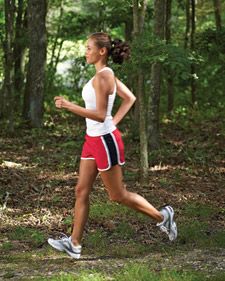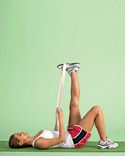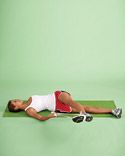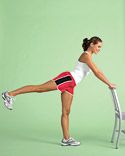Running 101 : Running Plan, Posture and Cool down Exercises
In this detailed info on The Power of Running, we will cover, Your Running Plan, reasonable long-term goal: form, how to increase duration: Listen to your body and Running Posture along with Cooldown Exercises. At the end of the article we also provide you with contact details to get in touch with one of our experts who can help create a personalized plan just for you.
Yes, you can run! Its benefits — improved cardiovascular health, stronger bones, a big calorie burn, longer life — are well worth the effort you put in. Find your stride with this expert advice.
You watch runners trotting by and think, “I could never do that.” Running causes too much wear and tear on the body anyway, right? And besides, only the superfit can run.
Not true! With the right training, almost anyone can do it — and we have plenty of reasons to try. Research suggests that running regularly keeps your joints healthy and slows the aging process. James Fries, M.D., emeritus professor of medicine at Stanford University School of Medicine, explains that joint cartilage is “the only tissue in the body that has living cells but no blood supply.” To stay healthy, joints need the compression from weight-bearing activities such as running to flush out waste products and draw in nutrients. Running also slows aging by protecting against bone loss, shedding pounds, and preventing cardiovascular disease.
Interested? To get you started, we turned to Diane Proud, running and triathlon pro at the Cooper Fitness Center in Dallas, who has coached hundreds of people off the couch and onto the running track. Even if you’ve never so much as run for a bus, with our easy step-by-step plan, you’ll be cruising along to better health in no time.
Your Running Plan
This program focuses on beginners, letting them develop at their own pace. Make sure you read all the steps before heading out.
Set a reasonable long-term goal.
Proud suggests aiming to run three miles after three months, a modest goal that minimizes the risk of injury. You also can fit three miles into a busy schedule with relative ease (even at a slow pace, a half-hour should do it), increasing your chance of sticking with the program. To motivate yourself, sign up for a 5K race (roughly three miles) three months from now.
Start slowly.
For the first few weeks, aim to run for just 10 minutes total, alternating between walking and running. (It’ll help to wear a watch.) Warm up with five minutes of walking (not stretching, which potentially can weaken “cold” muscles), gradually building your speed until you break a light sweat. Next, jog lightly for 30 seconds to one minute, moving at a pace that allows you to talk while you run. Then, drop back to a brisk walk for one to two minutes, “just enough to get your breath under control again,” Proud says. “But don’t walk so slowly that you lose your momentum.” After you catch your breath, resume running for 30 seconds to one minute. At the end of your session, slow your pace and walk for three to five minutes to allow your heart rate to return to normal. Finish with stretches.
Pay attention to form.
The right posture helps your body move comfortably and efficiently. Keep your head up high and centered between your shoulders. Direct your gaze straight ahead, about 20 to 30 feet in front of you, and relax your jaw and shoulders. Bend your elbows at a 90-degree angle, with your hands loosely cupped. As your arms move back and forth, keep them close to your body. Land lightly on the balls of your feet, not your toes or heels. Your foot should hit the ground directly under your hip. With each step, concentrate on pushing back through your big toe. Check your posture periodically, because it’s common to slouch as you get tired.
Slowly increase duration.
With each outing, increase the number of minutes you run within that 10-minute block. Eventually you’ll run for the entire 10 minutes. Once you reach this milestone, increase your time running — but not by more than about 10 percent a week. That means you’ll add no more than a minute or two each week for a while. This may sound tortoise-slow, but an incremental approach helps develop cardiovascular strength. When new runners say they can’t catch their breath, it usually means they’re running too fast or too long, says Proud, and they’ve skimped on the foundation work. “Be patient,” she says. “Otherwise you’ll get hurt or really uncomfortable, and you’ll probably stop doing it.” Finish by slowing your pace and walking for three to five minutes, then stretch.
Get out there.
Short, frequent runs help you make it a habit and develop an efficient running technique, says Proud, so run at least three days a week. Beginners should not run two days in a row during the first month (to give the body a chance to properly recover). On your days off, try cross-training activities such as yoga, walking, or using an elliptical machine, she advises; the variety will make you stronger.
Listen to your body.
While some soreness is normal the day after you run, more severe pain may mean you’ve overdone it and strained a muscle. In that case, don’t run; try a cross-training activity such as cycling instead. The switch will help your muscles heal, and you can try again after a day or two.
Be kind to yourself.
Some people easily take to running; others need more time. Certain runners cruise along; others go at a slow pace, even after years of practice. Your best running mantra? Don’t compare. Success comes from getting up off the couch and exercising, not from running quickly or for a long time. Examine your strengths and weaknesses, acknowledge them, and be proud of your accomplishments, whatever they turn out to be.
Running Posture
Check your posture periodically, because it’s common to slouch as you get tired.
- Keep your head up high and centered between your shoulders.
- Bend your elbows at a 90-degree angle; keep arms close to your body.
- Push back through your big toe.
- Your foot should land under your hip.
- Loosely cup your hands.
- Relax your jaw and shoulders.
- Direct your gaze straight ahead.
Cooldown Exercises
Calf stretch with belt
What it does: Stretches the muscles and joints around the foot, ankle, and back of the knee, which allows you to run more fluidly.
How to do it: Lie on your back on a mat. Bring in your left leg so you can place a strap, long towel, or belt around the arch or ball of your foot. Holding the ends of the strap in your hands, straighten your left leg and raise your foot toward the ceiling; keep your right leg either straight or bent with the foot flat on the floor, whichever feels more comfortable. Flex your left toes to engage your calf muscles, and use the strap to gently pull them toward your shin. Take five to 12 deep breaths. Lower your left leg to the floor, and repeat on the opposite side.
Hip Stretch with Belt
What it does: Stretches the muscles in your hip complex; gives you greater range of motion; decompresses the ball-and-socket joint in your hip.
How to do it: Lie on your back on a mat. Place a strap just below the ball of your left foot, and then hold both ends of the strap in your right hand. Place your left arm flat on the floor so that it creates a 90-degree angle with your torso. Straighten your left leg, raising your foot toward the ceiling and flexing the toes; keep your right leg straight on the floor. Focus on keeping both shoulders on the ground. Take a deep breath and exhale, slowly lowering your left leg across your body until it hovers a few inches above the floor. Inhale and slowly raise your foot up toward the ceiling. Repeat three to five times. Now drop your left leg across your body and hold it there for five to 12 breaths. Repeat on the opposite side.
Standing Hamstring Stretch
What it does: Decompresses muscles and joints in and around your knee; rejuvenates deep hip muscles and lengthens your waist.
How to do it: Stand a foot away from the back of a chair and hold on to it with hands shoulder-width apart. Walk your feet backward several steps; your elbows should be straight but not locked, feet hip-width apart, knees slightly bent. Take five deep breaths; imagine your waist lengthening. Shift your weight onto your left leg. Inhale and raise your right leg behind you. Exhale and straighten your left leg, and then inhale and lift your right leg a few more inches. Hold for five to 12 breaths. Repeat on opposite side.
What’s next?
Get in touch with us today, Let our personal trainers in Dubai, Abu Dhabi, Sharja, Ajman or RAK help you get fitter. Your health is more important than you know.
Whatsapp number Dubai – UAE : +971 56 58 30067
Contact us : Click here to send us your details we will get back to you asap




